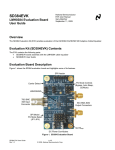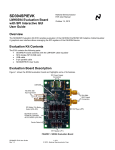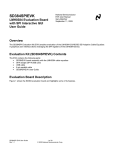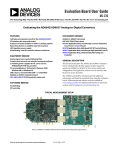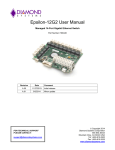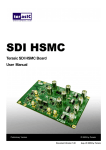Download (TI)
Transcript
SD384EVK LMH0384 Evaluation Board User Guide National Semiconductor EVK User Manual Gary Melchior September 11, 2009 Overview The SD384 Evaluation Kit (EVK) enables evaluation of the LMH0384 3G/HD/SD SDI Adaptive Cable Equalizer. Evaluation Kit (SD384EVK) Contents The EVK contains the following parts: • SD384EVK board assembly with the LMH0384 cable equalizer • SD384EVK User Guide Evaluation Board Description Figure 1 shows the SD384 evaluation board and highlights some of its features. Figure 1. SD384 Evaluation Board SD384 EVK User Guide Rev 1.2 1 of 5 © 2009, National Semiconductor Corp. SDI Input and SDO Output The SDI input connector (J1) is a 75Ω BNC connector. The SDI input should conform to the SMPTE 424M, SMPTE 292M, or SMPTE 259M standards. The SDO output connectors (J2 and J3) are 50Ω SMA connectors. When using only one side of the output pair, the other side should be terminated with a 50Ω SMA termination. For example, when only using the SDO output, ¯¯¯¯ SDO should be terminated with a 50Ω SMA termination. DC Power Connectors The VCC and GND power connectors should be powered with a DC input voltage of 3.3V ± 5% (3.6V maximum). SPI Mode / Pin Mode Select (JP1 – JP4) JP1, JP2, JP3, and JP4 are used to select between SPI Mode or Pin mode. To select Pin Mode, set four jumpers as shown in Figure 2, and to select SPI Mode, set four jumpers as shown in Figure 3. Either Pin Mode or SPI mode must be selected for proper operation; do not leave JP1-JP4 open. Figure 2. Pin Mode Select Figure 3. SPI Mode Select MUTEREF (JP5) JP5 allows control of the MUTEREF function and may be used in either Pin Mode or SPI Mode. MUTEREF is an input voltage used to set the threshold for ¯¯¯ CD . The MUTEREF DC input voltage should be between 0V and 3.3V. Refer to the LMH0384 datasheet for details. Leave JP5 unconnected for normal operation. Pin Mode Controls (JP6 – JP8) JP6, JP7, and JP8 are used to control LMH0384 features while the device is configured for Pin Mode. Jumpers should not be placed on JP6, JP7, or JP8 while the device is configured for SPI Mode. ¯¯¯ CD and MUTE (JP6) ¯¯¯ ) monitoring and MUTE control. ¯¯¯ JP6 allows Carrier Detect (CD CD is high when no input signal is present. MUTE may be used to force the outputs on or off, or tied to ¯¯¯ CD to allow automatic mute operation based on the input signal. To activate mute and force the outputs into a muted condition, set the jumper to pull MUTE to VCC. To turn off mute so that the outputs will never mute, set the jumper to tie MUTE to GND. For normal operation, set the jumper to tie ¯¯¯ CD to MUTE for automatic mute control. The LMH0384 MUTE pin has an internal pulldown (to disable mute), so JP6 may be left unconnected and the LMH0384 will never mute. SD384 EVK User Guide Rev 1.2 2 of 5 © 2009, National Semiconductor Corp. BYPASS (JP7) JP7 allows control of the equalization BYPASS function. To put the device into bypass mode, set the jumper to pull BYPASS to VCC. To turn off bypass (for normal operation) set the jumper to pull BYPASS to GND. The LMH0384 BYPASS pin has an internal pulldown (to disable bypass), so JP7 may be left unconnected for normal operation. AUTO SLEEP (JP8) JP8 allows control of the AUTO SLEEP function. To put the device into auto sleep mode in which it will power down when no input is detected, set the jumper to pull AUTO SLEEP to VCC. To turn off auto sleep and prevent the LMH0384 from automatically powering down, set the jumper to pull AUTO SLEEP to GND. The LMH0384 AUTO SLEEP pin has an internal pullup (to enable auto sleep), so JP8 may be left unconnected to enable auto sleep mode. SPI Header (JP9) JP9 is the SPI (Serial Peripheral Interface) header. It allows access to the SPI pins (¯¯¯ SS , MISO, MOSI, and SCK) while the LMH0384 is in SPI mode. These pins may be connected to a standard SPI controller to access the LMH0384 SPI registers. Refer to the LMH0384 datasheet for details. Carrier Detect LED (D1) D1 shows the status of Carrier Detect. This LED is GREEN when an input signal has been detected, and OFF when no input is detected. D1 shows the status of Carrier Detect while in Pin Mode or SPI Mode. Typical Performance Figures 4 and 5 show typical output waveforms of the SD384, with the 1m of Belden 1694A cable on the input and 110m of Belden 1694A cable on the input, respectively. The input signal is a 2.97 Gbps PRBS10, and the output signal is measured on the Agilent DCA-J 86100C Oscilloscope. Figure 4. SD384 Output Waveform at 2.97 Gbps with 1m Belden 1694A Cable SD384 EVK User Guide Rev 1.2 3 of 5 © 2009, National Semiconductor Corp. Figure 5. SD384 Output Waveform at 2.97 Gbps with 110m Belden 1694A Cable Bill of Materials Reference Designator C1, C7, C8 C2, C3, C4 C5, C6, C14, C16, C17 D1 J1 Qty 3 3 5 1 1 Description Capacitor, 4.7uF, 6.3V, X5R, 0603 Capacitor, 1uF, 6.3V, X5R, 0402 Capacitor, 0.1uF, 16V, X5R, 0402 LED, Green, 0603 BNC, Amphenol, 75-ohm, edge launch J2, J3 JP1, JP2, JP3, JP4, JP7, JP8 JP5 JP6 JP9 L1 2 6 1 1 1 1 PS1, PS2 R1, R2 R5 R4 2 2 1 1 SMA, 50-ohm, edge launch Header, 3x1, 0.1" Header, 2x1, 0.1" Header, 3x2, 0.1" Header, 6x1, 0.1" Inductor, 5.6nH, 0402 PCB Quick-Fit Male Terminal, .052" diameter, .250" tab size Resistor, 75-ohm, 1/16W, 1%, 0402 Resistor, 37.4-ohm, 1/16W, 1%, 0402 Resistor, 300-ohm, 1/10W, 5%, 0402 U1 1 LMH0384 Cable Equalizer, LLP-16 Schematic SD384 EVK User Guide Rev 1.2 4 of 5 © 2009, National Semiconductor Corp. Manufacturer Panasonic - ECG Panasonic - ECG Panasonic - ECG Lite-On Amphenol Johnson Components 3M/ESD 3M/ESD 3M/ESD 3M/ESD Murata Keystone Electronics Yageo Vishay/Dale Panasonic - ECG National Semiconductor Manufacturer Part No. ECJ-1VB0J475M ECJ-0EB0J105M ECJ-0EB1C104K LTST-C190GKT 31-6009 142-0701-851 929834-02-36 929834-02-36 929836-02-36 929834-02-36 LQP15MN5N6B02D 1287-ST RC0402FR-0775RL CRCW040237R4FKED ERJ-2GEJ301X LMH0384SQ GND PS2 2 1 PS1 2 1 SDI J1 C1 4.7uF Z75_1 BNC_EDGE C14 0.1uF L1 5.6nH 2 C16 0.1uF C15 open R1 75 JP2 1 2 3 VCC C17 0.1uF GND C2 1uF C3 1uF BYPASS CD GND R5 37.4 Z75_2 R2 75 HDR_3 VCC GND Z75_3 Z75_4 JP3 1 2 3 HDR_3 R4 300 C5 0.1uF CD GND CD D1 JP6 1 3 5 VEE SDI SDI SPI_EN 3 VCC C4 1uF JP4 1 2 3 HDR_3 GND VCC GND GND JP7 1 2 3 HDR_3 BYPASS C6 0.1uF U1 LMH0384 12 11 10 9 MUTEREF HDR_2 1 2 JP5 VEE/SS SDO SDO AUTOSLP/MISO GND VCC GND BYPASS VCC 4 JP8 1 2 3 HDR_3 4 C7 4.7uF C8 4.7uF JP9 SPI Header 5 SDO+ GND J2 SMA_R_EDGE SDO- GND SCK MOSI MISO SS GND 1 2 3 4 5 6 Z50_1 J3 SMA_R_EDGE HDR_6 Z50_2 GND Z50_1, Z50_2: W=40MIL, ZO=50+-5% SMA: 3/4 inch spacing, center to center 5 MUTE/SCK MOSI AUTOSLP/MISO VEE/SS Doc No. File: C:\SD384\LMH0344.SchDoc Print Date: 3/4/2009 Size: B Sheet 1 of 1 Rev: A SD384 Evaluation Board for LMH0384 Title ZDIFF100_P, ZDIFF100_N: DIFFERENTIAL 100OHM IMPEDANCE LAYOUT NOTE: ZDIFF100_N ZDIFF100_P AUTO SLEEP GND VCC Pin Mode Controls (do not place Jumpers JP6-8 for SPI Mode) 2 4 6 HDR_3X2 CD/MUTE LED 1 2 3 4 MOSI CD/MOSI CD 3 AUTOSLP/MISO 1 VCC GND VCC GND MUTE/SCK 8 LAYOUT NOTE: Z75_1: W=20MIL, ZO=75+-5% Z75_2: W=20MIL, ZO=75+-5% JP1 1 2 3 SPI Mode / Pin Mode Select (JP1-JP4) SPI Mode Pin Mode SPI_EN HDR_3 2 VEE/SS 13 VCC CD/MOSI MUTEREF MUTEREF 15 14 MUTE/SCK 7 BYPASS/CD BYPASS/CD CD/MOSI 16 VCC AEC6 AEC+ 5 17 DAP A B C D 1 SPI_EN 6 Company Confidential National Semiconductor 6 A B C D





